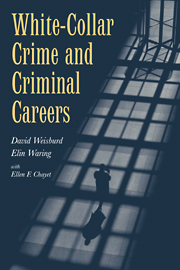Book contents
- Frontmatter
- Contents
- List of Figures
- List of Tables
- Acknowledgments
- Chapter One White-Collar Crime and Criminal Careers
- Chapter Two Dimensions of Official Criminal Careers
- Chapter Three Crimes of Crisis and Opportunity
- Chapter Four Chronic Offenders
- Chapter Five Prison Sanctions and Criminal Careers
- Chapter Six Understanding Recidivism
- Chapter Seven Conclusions
- Appendix A Detailed Information about the Sample
- Appendix B The Imprisonment Model
- References
- Index
Chapter Three - Crimes of Crisis and Opportunity
Published online by Cambridge University Press: 25 June 2009
- Frontmatter
- Contents
- List of Figures
- List of Tables
- Acknowledgments
- Chapter One White-Collar Crime and Criminal Careers
- Chapter Two Dimensions of Official Criminal Careers
- Chapter Three Crimes of Crisis and Opportunity
- Chapter Four Chronic Offenders
- Chapter Five Prison Sanctions and Criminal Careers
- Chapter Six Understanding Recidivism
- Chapter Seven Conclusions
- Appendix A Detailed Information about the Sample
- Appendix B The Imprisonment Model
- References
- Index
Summary
Studies of criminals and criminal careers often focus on those people with the longest and most serious criminal records. The study of “career criminals,” in this context, has played an important part in the development of knowledge about criminal careers and social factors that correlate with crime (Blumstein et al., 1986; Kempf, 1990; Rand Corporation, 1985). Despite this concern with more active offenders, it has long been recognized that many of those who are arrested, convicted, and even imprisoned will have only one, or a very small number, of contacts with the criminal justice system (e.g., see Blumstein et al., 1986; Tillman, 1987; Schmidt and Witte, 1988). Moreover, the study of “[o]ffenders with short careers who commit very few crimes” has, in principal, been recognized as an important area of inquiry for criminal career researchers (Blumstein et al., 1986, p. 14).
We saw in Chapter 2 that those with very limited official criminal records make up an even more substantial proportion of white-collar criminals than of street crime offenders. In this chapter our focus is on these less active offenders. How are they similar to or different from more chronic criminals in our sample? Do these offenders have characteristics ordinarily associated with criminality such as social instability, short sightedness, impulsiveness, and inability to delay gratification? Or can we say that these low-frequency white-collar offenders are not very different from other people in similar circumstances who do not commit crime?
- Type
- Chapter
- Information
- White-Collar Crime and Criminal Careers , pp. 51 - 72Publisher: Cambridge University PressPrint publication year: 2001



